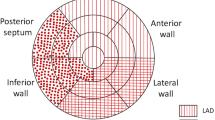Summary
The clinically applied value of myocardial perfusion and systolic function in patients with coronary artery disease after coronary artery bypass surgery using real-time myocardial contrast echocardiography (RT-MCE) combined with two-dimensional strain echocardiography was assessed. Twenty patients underwent intravenous RT-MCE by intravenous injections of SonoVue before and after coronary artery bypass surgery. Two-dimensional images were recorded from the left ventricular four-chamber view, two-chamber view and the apical view before, and two weeks and three months after coronary artery bypass surgery, and the peak systolic longitudinal strain was measured. The results showed that myocardial perfusion was significantly increased after coronary artery bypass surgery in about 71.6% segments. In the group that myocardial perfusion was improved, the peak systolic longitudinal strain three months after bypass surgery was significantly higher than that before operation [(−15.78±5.91)% vs (−10.45±8.31)%, P<0.05]. However, the parameters did not change in the group without myocardial perfusion improvement [(−10.33±6.53)% vs (−9.41±6.09)%, P>0.05]. It was concluded that whether or not the improvement of myocardial perfusion can mirror the recovery trend of regional systolic function, two-dimensional strain echocardiography can observe dynamic change of regional systolic function. The combination of myocardial perfusion with two-dimensional strain echocardiography can more accurately assess the curative effectiveness of coronary artery bypass surgery.
Similar content being viewed by others
References
Coggins MP, Sklenar J, Le DE, et al. Noninvasive prediction of ultimate infarct size at the time of acute coronary occlusion based on the extent and magnitude of collateral-derived myocardial blood flow. Circulation, 2001, 104(20):2471–2477
Aggeli C, Bonou M, Stefanadis C. Potential clinical applications of myocardial contrast echocardiography in evaluating myocardial perfusion in coronary artery disease. Int J Cardiol, 2005,104(1):1–9
Sieswerda GT, Yang L, et al. Real-time perfusion imaging: a new echocardiographic technique for simultaneous evaluation of myocardial perfusion and contraction. Echocardiography, 2003,20(6):545–555
Pérez David E, García Fernández MA. Assessment of myocardial functional recovery in reperfused AMI: the clinical impact of visual and quantitative analysis in MCE. Eur J Echocardiogr, 2004,5(2):S24–37
Tei C, Sakamaki T, Shah PM, et al. Myocardial contrast echocardiography: a reproducible technique of myocardial opacification for identifying regional perfusion deficits. Circulation, 1983,67(3):585–593
Greaves K, Dixon SR, Fejka M, et al. Myocardial contrast echocardiography is superior to other known modalities for assessing myocardial reperfusion after acute myocardial infarction. Heart, 2003,89(2):139–144
Tsutsui JM, Elhendy A, Anderson JR, et al. Prognostic value of dobutamine stress myocardial contrast perfusion echocardiography. Circulation, 2005,112(10):1444–1450
Abe Y, Muro T, Sakanoue Y, et al. Intravenous myocardial contrast echocardiography predicts regional and global left ventricular remodelling after acute myocardial infarction: comparison with low dose dobutamine stress echocardiography. Heart, 2005,91(12):1578–1583
Fukuda S, Hozumi T, Muro T, et al. Quantitative intravenous myocardial contrast echocardiography predicts recovery of left ventricular function after revascularization in chronic coronary artery disease. Echocardiography, 2004,21(2):119–124
Agati L, Voci P, Autore C, et al. Combined use of dobutamine echocardiography and myocardial contrast echocardiography in predicting regional dysfunction recovery after coronary revascularization in patients with recent myocardial infarction. Eur Heart J, 1997,18(5):771–779
Langeland S, D’hooge J, Wouters PF, et al. Experimental validation of a new ultrasound method for the simultaneous assessment of radial and longitudinal myocardial deformation independent of insonation angle. Circulation, 2005,112(14):2157–2162
Reisner SA, Lysyansky P, Agmon Y, et al. Global longitudinal strain: a novel index of left ventricular systolic function. J Am Soc Echocardiogr, 2004,17(6):630–633
Modesto KM, Cauduro S, Dispenzieri A, et al. Two-dimensional acoustic pattern derived strain parameters closely correlate with one-dimensional tissue Doppler derived strain measurements. Eur J Echocardiogr, 2006,7(4):315–321
Serri K, Reant P, Lafitte M, et al. Global and regional myocardial function quantification by two-dimensional strain: application in hypertrophic cardiomyopathy. J Am Coll Cardiol, 2006,47(6):1175–1181
Leitman M, Lysyansky P, Sidenko S, et al. Two-dimensional strain—a novel software for real time quantitative echocardiographic assessment of myocardial function. J Am Soc Echocardiogr, 2004,17(10):1021–1029
Liang HY, Cauduro S, Pellikka P, et al. Usefulness of two-dimensional speckle strain for evaluation of left ventricular diastolic deformation in patients with coronary artery disease. Am J Cardiol, 2006,98(12):1581–1586
Swinburn JM, Lahiri A, Senior R. Intravenous myocardial contrast echocardiography predicts recovery of dysynergic myocardium early after acute myocardial infarction. Am Coll Cardiol, 2001,38(1):19–25
Wei K, Jayaweera AR, Firoozan S, et al. Quantification of myocardial blood flow with ultrasound-induced destruction of microbubbles administered as a constant venous infusion. Circulation, 1998,97(5):473–483
Tanaka H, Kawai H, Tatsumi K, et al. Relationship between regional and global left ventricular systolic and diastolic function in patients with coronary artery disease assessed by strain rate imaging. Circ J, 2007,71(4):517–523
Ito H, Okamura A, Iwakura K, et al. Myocardial perfusion patterns related to thrombolysis in myocardial infarction perfusion grades after coronary angioplasty in patients with acute anterior wall myocardial infarction. Circulation, 1996, 93(11):1993–1999
Sakuma T, Otsuka M, Okimoto T, et al. Optimal time for predicting myocardial viability after successful primary angioplasty in acute myocardial infarction: A study using myocardial contrast echocardiography. Am J Cardiol, 2001,87(6):687–692
Rovai D, Lubrano V, Vassalle C, et al. Detection of perfusion defects during coronary occlusion and myocardial reperfusion following thrombolysis by intravenous administration of the echo enhancing agent BRI. J Am Soc Echocardiogr, 1998,11(2): 169–180
Lepper W, Hoffmann R, Kamp O, et al. Assessment of myocardial reperfusion by intravenous myocardial contrast echocardiography and coronary flow reserve after primary percutaneous transluminal coronary angioplasty [correction of angiography] in patients with acute myocardial infarction. Circulation, 2000,101(20):2368–2374
Andrássy P, Zielinska M, Busch R, et al. Myocardial blood volume and the amount of viable myocardium early after mechanical reperfusion of acute myocardial infarction: prospective study using venous contrast echocardiography. Heart, 2002,87(4):350–355
Brown PM Jr, Kim VB, Boyer BJ, et al. Regional left ventricular systolic function in humans during off-pump coronary bypass surgery. Circulation, 1999,100(19):125–127
Author information
Authors and Affiliations
Rights and permissions
About this article
Cite this article
Liu, R., Deng, Y., Bi, X. et al. Assessment of myocardial perfusion and systolic function in patients with coronary artery disease after coronary artery bypass surgery by myocardial contrast echocardiography and two-dimensional strain echocardiography. J. Huazhong Univ. Sci. Technol. [Med. Sci.] 29, 664–668 (2009). https://doi.org/10.1007/s11596-009-0526-1
Received:
Published:
Issue Date:
DOI: https://doi.org/10.1007/s11596-009-0526-1



